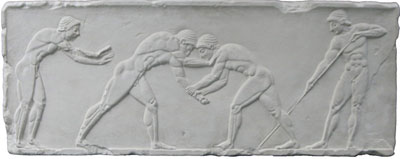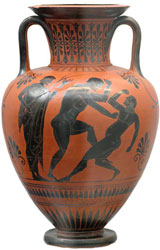History of Wrestling
In Ancient Greece, wrestling occupied a prominent place in legend and literature; wrestling competition was the number one sport of the Olympic Games. The ancient Romans borrowed heavily from Greek wrestling.
The first recorded Olympic wrestling match occurred in the Olympics in 708 BC. Wrestling was highly valued as a form of military exercise without weapons. There were two distinct versions of the game, differing according to the holds and the methods of deciding the victor.

Variations
Orthia pale (Upright and Proper Wrestling)The object of this type of wrestling was simply to throw the opponent to the ground. Three falls constituted a loss for that opponent, and the winner was called the "triakter". The match continued without stops until one man emerged victorious.
Kato pale (Ground Wrestling)
Victory in this competition depended on one competitor acknowledging defeat. Defeat was indicated by raising one's right hand with the index finger pointed.
Rules of the Game
Blows were not allowed.Tripping was permitted.
No biting or gouging was allowed.
There was no weight distinction.
The wrestlers were anointed with olive oil then dusted with powder to make them easier to grasp. The competition took place in the "keroma", or beeswax, a muddy and sticky arena.
Characteristics of a Good Wrestler
Since there was no weight provision in the Olympics, it is obvious that the sport required a strong and stout build. A special combination of agility, skill and craft were also necessary.

Additional Information
With five victories at Olympia, perhaps the most famous and successful of Olympic wrestlers was Milo. When attempting his sixth Olympic victory at forty years old, he was finally beaten by a younger man.
Nowadays there are weight/age divisions in wrestling competitions with girls vs boys up to the age of 14 years. Male and Female separate after age 14. Freestyle and Greco competitions.
Copyright © 2007–2025 Combat Sports School Olympic Wrestling Club. A division of the Todd Group.
